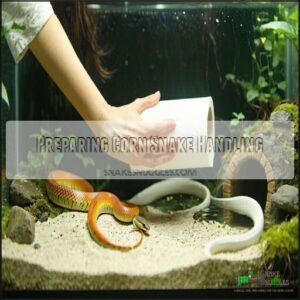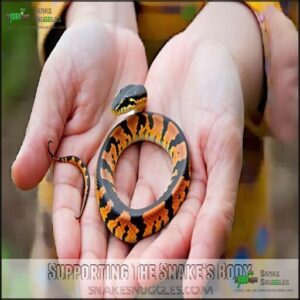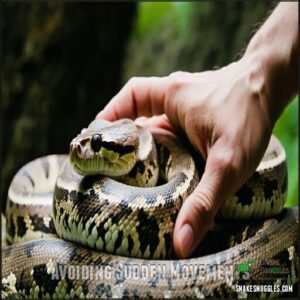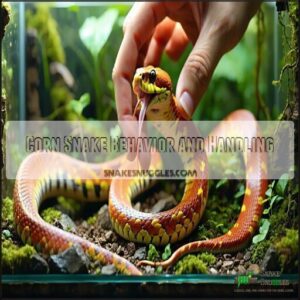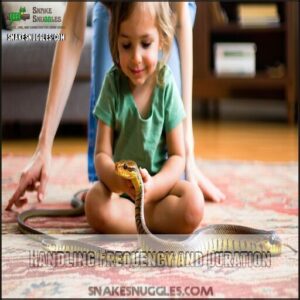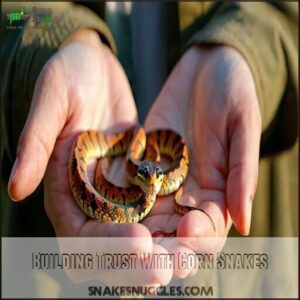This site is supported by our readers. We may earn a commission, at no cost to you, if you purchase through links.
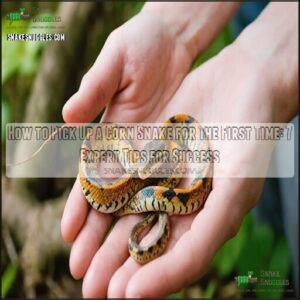
Approach from the side rather than above—snakes get nervous when shadows loom overhead, just like we do. Gently slide one hand under the middle of the snake’s body while supporting the rest with your other hand.
Don’t grab the tail or head. Keep movements slow and deliberate, holding the snake loosely but securely. If your snake seems stressed (rapid breathing, tense muscles), return it to its enclosure.
Remember, snakes aren’t born cuddlers—establishing trust takes time, much like making friends with that shy neighbor down the street, and it requires slow and deliberate movements and handling the snake gently.
Table Of Contents
- Key Takeaways
- Preparing Corn Snake Handling
- Picking Up Corn Snakes
- Handling Techniques and Tips
- Corn Snake Behavior and Handling
- Handling Frequency and Duration
- Building Trust With Corn Snakes
- Frequently Asked Questions (FAQs)
- How to start handling corn snakes?
- Why won’t my corn snake let me pick him up?
- Can I pick up my corn snake?
- How do you pick up a corn snake?
- How do you train a corn snake?
- Do corn snakes coil up?
- How long does it take to handle a corn snake?
- Should you handle a corn snake after a meal?
- When should you handle corn snakes?
- What Type of Enclosure is Best for a Corn Snake?
- Conclusion
Key Takeaways
- You’ll need to wait at least 2 weeks after bringing your corn snake home before attempting to handle it, allowing time for proper acclimation and reduced stress.
- Support your snake’s entire body when lifting, approaching from the side rather than above, and never grab the head or tail to prevent defensive behaviors.
- Keep your movements slow and deliberate during handling sessions, maintaining a loose but secure grip that allows natural movement while providing stability.
- Limit initial handling sessions to just 5 minutes once or twice weekly, gradually increasing duration as your snake shows signs of comfort through relaxed muscles and curious tongue flicks.
Preparing Corn Snake Handling
Before you pick up your corn snake for the first time, you’ll need to create a calm environment and gather the right tools like a snake hook for a stress-free experience.
You’ll want to make certain your snake is awake by gently tapping its enclosure with a paper towel roll, which prevents that startled "I-was-napping" reaction that can lead to defensive behavior.
Acclimating The Snake
Frequently, new corn snake owners rush into handling, which can stress your new pet.
Always allow proper acclimation time before your first snake handling attempt.
- Wait 3-5 days after bringing your snake to its new home
- Maintain proper temperatures (75-80°F cool side, 83-86°F warm side)
- Avoid handling until after the first shed
- Allow a full 2-week initial wait period
- Focus on reducing stress through gradual introduction
This patience builds snake trust and guarantees successful handling later.
Secure hiding spots help them feel safe and are crucial for successful handling.
Choosing The Right Environment
For successful corn snake handling, your environment matters as much as your technique.
Choose a quiet, warm room without distractions or loud noises.
You’ll want temperature gradients similar to their enclosure, around 75-85°F, with moderate humidity levels.
Keep your snake away from drafty windows and curious pets.
Make certain you’re on a non-slip surface with enough space for movement.
Having the snake’s enclosure nearby offers a quick retreat if needed, ensuring a safe and warm environment, which is crucial for successful corn snake handling.
Handling Tools and Equipment
A few essential tools can make your first-time corn snake handling substantially easier.
Use a properly sized snake hook (about 12-18 inches) to gently lift your snake without startling it.
Keep non-slip surfaces nearby, and consider lightweight cotton gloves if you’re nervous.
Always handle near the enclosure for quick returns if needed.
A quality hook can provide safer snake handling for a better experience.
Paper towel rolls work wonderfully as hook alternatives when you’re just starting out, offering a safer and more practical solution.
Picking Up Corn Snakes
Approaching your corn snake with confidence is half the battle in successful first-time snake handling.
When picking up your reptilian friend, remember these key steps:
Confidence and gentleness go hand in hand—support your snake’s body fully and move slowly to build trust.
- Start by gently tapping the snake with a paper towel roll to confirm it’s awake
- Use a snake hook for safe lifting or slide your hand beneath its body if no hook is available
- Position your hand about mid-body, never grabbing the tail or head
For juvenile handling, you’ll need just one hand, while adults require two for proper support.
Remember to handle them gently to avoid causing unnecessary stress.
Some beginners prefer glove usage until they’re comfortable with hand placement and snake lifting techniques.
Handling Techniques and Tips
You’ll need to support your corn snake’s entire body when handling, as this prevents injury and helps your new scaly friend feel secure.
With gentle movements and a confident grip that isn’t too tight, you’ll soon find your corn snake relaxing in your hands rather than trying to make a dramatic escape worthy of a reptilian action movie, which will help it feel secure.
Supporting The Snake’s Body
Holding your corn snake properly means giving it full body support at all times.
When lifting your snake, distribute its weight evenly across your hands and arms like a living bridge. Never grab or restrain the head—this stresses your snake and may trigger defensive biting.
Instead, maintain a secure grip by letting it move freely while supporting its whole body. For juveniles, you’ll need just one hand, while adults require both arms.
This snake handling technique prevents injury and builds trust. For additional support, consider using a reptile body sling.
Think of yourself as a moving tree branch, providing stability while allowing natural movement, and always remember to handle your snake with care to ensure its well-being and safety, promoting a healthy and secure environment.
Avoiding Sudden Movements
When handling your corn snake, think of yourself as a sloth—slow and deliberate movements are key. Your corn snake can sense vibrations and quick motions may trigger their defensive instincts.
Use a calm approach with steady hands, moving gradually when reaching into the enclosure. Predictable handling builds trust; avoid jerky movements or sudden position changes that might startle your new pet.
A gentle touch and consistent speed during first-time snake handling will keep your corn snake relaxed. Remember, safe snake handling isn’t a race—beginner snake care is all about patience.
It’s also important to avoid handling during shedding, as their vision may be impaired.
Corn Snake Behavior and Handling
You’ll learn to read your corn snake’s mood by watching for tongue flicks and body posture, just like decoding a scaly friend’s secret language.
When you understand these behavioral cues, you can adjust your handling technique accordingly, making pickup time stress-free for both you and your slithery companion.
Recognizing Defensive Behavior
A watchful eye can save you from corn snake defensive behaviors. When handling your snake, look for the S-shaped coiled posture and hissing, which signal strike prevention is needed.
Tail rattling and body puffing are clear musking signals that your pet feels threatened. If cornered, defensive bites may occur.
Understanding these defensive instincts through careful observation of snake body language guarantees safe snake handling techniques and builds trust.
Understanding Tongue Flicking
Through the flicks of a corn snake’s tongue, you’ll witness its primary way of sensing the environment.
Through every quick tongue flick, your corn snake maps its world, translating scents into a mental landscape only it can see.
When your snake flicks rapidly, it’s collecting scent particles to understand its surroundings. This behavior isn’t aggression but normal communication signals and prey detection.
The frequency of tongue flicking can also serve as a health indicator during snake handling interactions. Corn snakes also use tongue flicks to express curiosity and exploration.
Don’t worry—it’s just your snake saying hello in its own language, which is a sign of curiosity and can be considered a form of exploration.
Identifying Signs of Stress
While your corn snake’s tongue flicking shows curiosity, you’ll need to recognize stress signals too.
Watch for defensive postures like an S-shaped neck or raised head. Your snake might release a foul-smelling musk, shake its tail, or hiss when stressed.
Erratic movements, breathing changes, and appetite loss are also warning signs.
With proper corn snake handling techniques, you’ll quickly learn your pet’s unique temperament and adjust your approach accordingly.
Handling Frequency and Duration
You’ll need to handle your corn snake regularly enough to build trust but not so often that you stress it out.
Start with short 5-minute sessions twice weekly after your snake has settled in for two weeks, gradually working up to 15 minutes as your snake becomes more comfortable with being your scaly workout partner.
Initial Handling Sessions
Now that you understand corn snake behavior, let’s focus on your first handling sessions.
Start during your first week with just 5-minute sessions, use a gentle approach, keeping interactions brief and positive.
Observe behavior closely—if your snake seems stressed, end the session.
These short meetings help build confidence for both you and your snake, and first-time snake handling success depends on patience and consistency.
Gradually Increasing Handling Time
As your snake becomes familiar with handling, it’s time to extend your session length.
Start by adding 1-3 minutes every 4-7 days to your handling schedule. When your corn snake shows behavioral cues of comfort—relaxed muscles and curious tongue flicks—you’ve hit the sweet spot.
Don’t rush this process; building positive associations takes patience. Soon, you’ll develop snake handling confidence and enjoy longer, stress-free interactions with your scaly friend.
Avoiding Overhandling
After establishing a handling routine, don’t overdo it. Even the friendliest corn snake needs downtime—too much interaction can trigger defensiveness.
Limit sessions to 15-20 minutes and handle your snake just 1-2 times weekly. Watch for stress signals like rapid movement or hiding.
When you’re finished, gently return your snake to its enclosure. Remember, quality over quantity makes for a healthy first-time snake handling experience.
Building Trust With Corn Snakes
You’ll need to establish trust with your corn snake through consistent, gentle interactions that help it recognize you’re not a threat.
Just like that shy friend who eventually warms up after a few game nights, your snake will gradually shift from cautious to curious with regular handling sessions that follow its comfort signals, allowing it to understand that you’re gentle.
Positive Reinforcement Techniques
Now that you’ve mastered handling duration, let’s focus on building your snake’s confidence through positive reinforcement.
Reward systems work wonders for corn snake handling success.
Try these techniques with your scaly friend:
- Offer small treats after calm handling sessions
- Gradually increase handling time from 5 to 10 minutes as comfort improves
- Use gentle guidance during exploration to reinforce positive associations
This approach transforms first-time snake handling from potentially stressful to genuinely rewarding for both of you, promoting a successful handling experience.
Establishing a Handling Routine
Your corn snake will thrive when you establish a consistent schedule for handling sessions.
Try setting aside 5-10 minutes every other day at roughly the same time—maybe after work or before dinner.
This gradual introduction creates positive associations with being handled.
The benefits of a personalized approach become clear as your snake recognizes the routine and shows less stress during first-time handling experiences.
Monitoring Snake Behavior and Adjusting Handling Techniques
Through consistent handling, you’ll learn to read your corn snake’s signals.
Watch for stress indicators like rapid breathing or defensive postures, and adjust your approach accordingly. If your snake seems uncomfortable, try shorter sessions or different handling techniques.
Over time, you’ll recognize behavioral changes that show improved comfort levels. Remember, understanding snake behavior and body language is key to building trust with your scaly friend.
Frequently Asked Questions (FAQs)
How to start handling corn snakes?
Wait two weeks after bringing your snake home.
Then use a snake hook to gently lift it a few inches behind the head.
Support its entire body and keep handling sessions short initially.
Why won’t my corn snake let me pick him up?
Your corn snake may be skittish as a jackrabbit if he’s new, stressed, or shedding.
Try approaching from the side, using a hook first, and keeping handling sessions short until he’s comfortable with you.
Can I pick up my corn snake?
Yes, you can pick up your corn snake.
Support its body fully, approach from the side, and move slowly.
Start with short 5-minute sessions after it’s settled in for two weeks and eating regularly.
How do you pick up a corn snake?
Approach gently, tap with a paper towel roll first.
You’ll want to support your corn snake’s entire body, sliding your hand underneath and lifting slowly.
Don’t grab the head or tail.
How do you train a corn snake?
You don’t actually train corn snakes like dogs, but you’ll help them become comfortable with handling through regular, short sessions.
Start after they’ve settled in, and gradually increase handling time when they seem relaxed.
Gradually increasing handling time is crucial when they seem to be in a comfortable state.
Do corn snakes coil up?
Like coiled springs ready to unwind, corn snakes do coil up for comfort and security.
You’ll often see them forming loose or tight loops when resting, basking, or feeling threatened in their environment.
How long does it take to handle a corn snake?
Start with 5-minute sessions when your corn snake settles in.
Gradually increase to 10-15 minutes over weeks.
Don’t handle within 48 hours after feeding or during shedding.
Keep sessions to 1-2 times weekly, this will help prevent stress on the snake.
Should you handle a corn snake after a meal?
No, you shouldn’t handle a corn snake within 48 hours after feeding.
Your snake needs time to digest properly, and handling during this period could cause stress or regurgitation, which is harmful to its health.
When should you handle corn snakes?
You should handle corn snakes 1-2 times weekly, but never within 48 hours after feeding or during shedding. Wait 2 weeks after bringing them home, and keep initial sessions under 5 minutes.
What Type of Enclosure is Best for a Corn Snake?
A palace-worthy glass terrarium (20-gallon) is your best choice for a corn snake.
You’ll want secure locking lids, proper ventilation, and enough space for climbing branches.
Plastic tubs work nicely for beginners too.
Conclusion
Did you know that 95% of corn snake owners report successful handling within the first three attempts.
Learning how to pick up a corn snake for the first time is your gateway to a rewarding relationship with these fascinating reptiles.
With patience, proper technique, and respect for your snake’s boundaries, you’ll build trust that lasts for years.
Remember, every snake has its own personality—yours might be shy today but curious tomorrow.
Consistent, gentle handling makes all the difference.
- https://www.youtube.com/c/LoriTorriniAnimalBehavior
- https://www.reptifiles.com/corn-snake-care-guide/corn-snake-diseases-health/corn-snake-shedding/
- https://image.petmd.com/files/2024-12/1730300-24-10-PMD-CornSnakeCareSheet.pdf?VersionId=C85M2VWn84MucQ1nerMeMYFQ3gfu0JZS?utm_source=petmd.com&utm_campaign=caresheet&utm_medium=PDF

